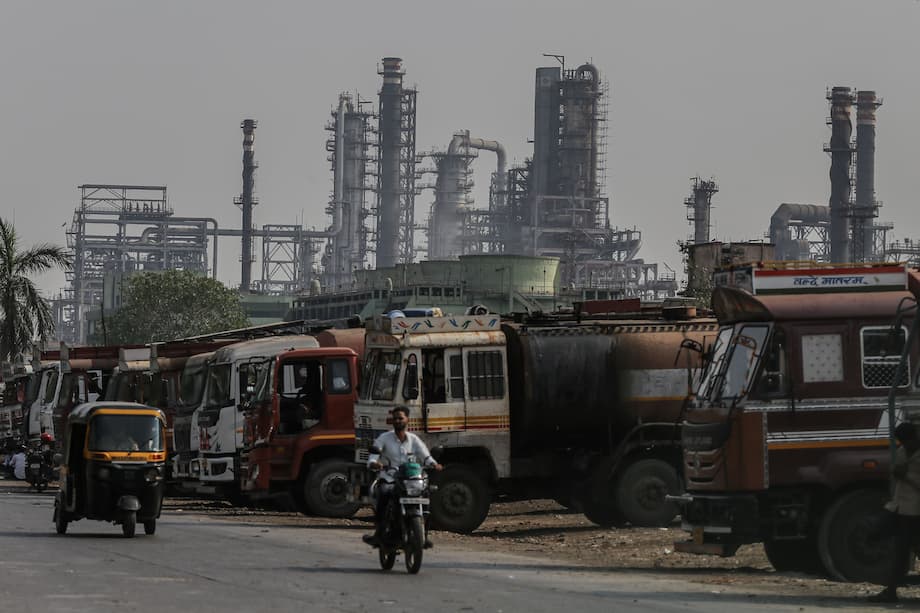India Faces US Tariffs Over Russian Oil Imports: The High-Stakes Clash Between Energy Security and Geopolitics
In a dramatic escalation of global trade tensions, the United States has announced steep new tariffs on Indian goods, citing India’s continued imports of Russian oil as the primary reason. The move, spearheaded by President Donald Trump, has not only strained the once-warm relationship between Washington and New Delhi but also exposed deep rifts in the international response to Russia’s war in Ukraine. As India pushes back against what it calls “unjustified” and “unreasonable” pressure, the world is watching to see how this standoff will reshape global energy markets, diplomatic alliances, and the future of US-India relations.
- India Faces US Tariffs Over Russian Oil Imports: The High-Stakes Clash Between Energy Security and Geopolitics
- Why Is the US Targeting India Over Russian Oil?
- India’s Response: Defiance and Accusations of Hypocrisy
- How Did We Get Here? The Roots of the Dispute
- What’s Happening on the Ground? Oil Tankers, Market Reactions, and Industry Moves
- Broader Implications: Trade, Diplomacy, and the Global Order
- What Happens Next? The Road Ahead for India, the US, and Global Energy
- In Summary
Why Is the US Targeting India Over Russian Oil?
President Trump’s decision to raise tariffs on Indian goods marks a significant shift in US foreign policy. The administration argues that India, now the world’s fourth-largest economy, is undermining Western efforts to isolate Russia by purchasing large volumes of discounted Russian crude oil. Trump has accused India of not only buying but also reselling Russian oil for profit, thereby indirectly financing Moscow’s war in Ukraine.
“India is not only buying massive amounts of Russian oil, they are then, for much of the oil purchased, selling it on the open market for big profits,” Trump wrote on social media. “They don’t care how many people in Ukraine are being killed by the Russian war machine. Because of this, I will be substantially raising the tariff paid by India to the USA.”
The new tariffs—set at a minimum of 25% on Indian imports, with the threat of even higher penalty tariffs specifically for Russian oil purchases—are among the harshest imposed on any US trading partner in recent years. The US imported $87.4 billion in Indian goods in 2024, making India a major commercial partner and a key player in global supply chains.
Secondary Tariffs: A New Tool in US Foreign Policy
What makes this episode especially notable is Trump’s use of what he calls “secondary tariffs”—penalties imposed not just for direct trade with Russia, but for doing business with countries that continue to buy Russian energy. This approach represents a shift from traditional financial sanctions to a broader use of tariffs as a tool of geopolitical pressure.
India’s Response: Defiance and Accusations of Hypocrisy
India has responded forcefully to the US measures, rejecting the criticism as unfair and pointing out what it sees as Western hypocrisy. Indian officials argue that their increased imports of Russian oil began only after traditional suppliers redirected their oil to Europe following the Ukraine invasion. They also note that the US and European Union continue to trade with Russia in other sectors, including chemicals, fertilizers, machinery, and even energy products like uranium and liquefied natural gas (LNG).
Randhir Jaiswal, spokesperson for India’s Ministry of External Affairs, stated:
“India will protect its economic interests in the face of threats of steep tariffs from President Donald Trump. The targeting of India is unjustified. Our imports of Russian oil began only after Western countries reduced their own supplies to Europe following the Ukraine war.”
India’s foreign ministry further emphasized that its oil imports are a necessity, not a choice, and are essential for keeping energy prices stable and affordable for its 1.4 billion citizens. The ministry pointed out that the EU’s bilateral trade with Russia was €67.5 billion in 2024—significantly more than India’s total trade with Russia.
India’s Energy Security Dilemma
India imports about 80% of its oil needs, making energy security a top national priority. Since the Ukraine war began, Russia has become India’s leading oil supplier, with imports rising from under 100,000 barrels per day to over 1.8 million barrels per day in 2023—accounting for nearly 39% of India’s total oil imports. These purchases are largely driven by price: Russian crude is sold at a discount compared to other sources, helping India manage inflation and support its fast-growing economy.
Indian officials and energy experts argue that abruptly cutting off Russian oil is not feasible. Alternatives like Iran and Venezuela are themselves under US sanctions, and Middle Eastern supplies are limited and often more expensive. Moreover, India’s purchases of Russian oil help keep global prices lower, benefiting not just India but also other countries—including the US and Europe, which import refined products made from Russian crude processed in Indian refineries.
How Did We Get Here? The Roots of the Dispute
The current standoff is the culmination of months of tense negotiations between Indian and American trade officials. The US has long complained about India’s high tariffs on American goods and its reluctance to open up sectors like agriculture and dairy. India, for its part, has sought to protect its farmers and small businesses while pushing for greater access to the US market for its own exports.
Trade talks had made progress, but Trump’s decision to link the issue to India’s relationship with Russia has thrown a wrench into the process. The US president’s insistence on a hard deadline for Russia to end the war in Ukraine—and his threat to impose 100% tariffs on countries that continue to buy Russian energy—has left little room for compromise.
India’s Longstanding Ties With Russia
India’s partnership with Russia extends far beyond oil. The two countries have deep historical ties dating back to the Cold War, when the Soviet Union was India’s primary supplier of arms and diplomatic support. Today, India remains Russia’s top arms customer, even as it has diversified its defense purchases and strengthened relations with the US and other Western nations.
This longstanding relationship complicates India’s position. While New Delhi has condemned civilian casualties in Ukraine and called for an end to the conflict, it has resisted Western pressure to distance itself from Moscow, citing its own strategic and economic interests.
What’s Happening on the Ground? Oil Tankers, Market Reactions, and Industry Moves
The impact of the US tariff threats is already being felt in the real world. According to reports from The Moscow Times and NDTV Profit, at least four tankers carrying Russian crude have been idling off India’s western coast, delayed by mounting sanctions and uncertainty over future trade rules. Indian authorities have reportedly instructed state-run refiners to draw up contingency plans and explore alternative suppliers, including Middle Eastern and West African producers.
Despite these moves, Indian officials insist there has been no official policy change. Private refiners such as Reliance Industries and Nayara Energy (partially owned by Russia’s Rosneft) continue to import Russian oil, while state-owned companies have paused purchases only temporarily as discounts narrow and the market assesses the risk of US penalties.
Market Impact: Oil Prices and Global Supply Chains
The tariff threats have also rattled global oil markets. Brent crude prices rebounded after hitting a five-week low, as traders weighed the possibility of reduced Indian demand for Russian oil and the broader implications for global supply. Analysts note that India’s continued purchases have helped keep oil prices in check, and any sudden shift could trigger price spikes and supply disruptions worldwide.
“Expectations appear that India may reduce its buying of Russian crude, but I can’t see them doing so entirely as they have been making supernormal profits on buying cheap Russian crude,” said Ashley Kelty, an analyst at Panmure Liberum.
Broader Implications: Trade, Diplomacy, and the Global Order
The US-India tariff dispute is about more than just oil. It reflects the growing complexity of global trade and diplomacy in an era of shifting alliances and economic nationalism. As companies have moved manufacturing out of China in recent years, India has emerged as a leading alternative for electronics, pharmaceuticals, and other goods. The new tariffs threaten to blunt India’s competitive edge and could encourage businesses to look elsewhere.
For the US, the move is part of a broader strategy to pressure Russia and its trading partners, but it risks alienating a key ally in the Indo-Pacific region. The relationship between Trump and Indian Prime Minister Narendra Modi, once marked by public displays of friendship, has become increasingly strained as both leaders face domestic and international criticism.
India’s Calculated Defiance
Despite the pressure, India shows no sign of backing down. Officials have made it clear that energy security and national interest will guide their decisions, not external demands. As one senior Indian official told The Guardian:
“These are long-term oil contracts. It is not so simple to just stop buying overnight. Our refineries operate in full compliance with international norms, and Russian oil has never been directly sanctioned by the US or EU.”
India’s stance is supported by many experts, who argue that the country’s purchases of Russian oil are both legitimate and essential for global market stability. If India were to abruptly halt imports, they warn, the resulting supply shock could drive prices higher and hurt consumers worldwide.
What Happens Next? The Road Ahead for India, the US, and Global Energy
With the US tariffs set to take effect and no sign of a breakthrough in trade talks, the standoff is likely to continue in the coming months. Indian officials are exploring ways to mitigate the impact, including shifting exports to other markets, boosting domestic consumption, and seeking new energy suppliers. However, most analysts agree that India’s reliance on Russian oil will not end overnight.
Meanwhile, the US faces its own challenges. By targeting India, Washington risks undermining a key partnership in its broader strategy to counter China and maintain influence in Asia. The use of secondary tariffs as a tool of foreign policy may also set a precedent for future disputes, raising questions about the balance between economic leverage and diplomatic engagement.
As the world grapples with the fallout from the Ukraine war, the US-India tariff clash serves as a stark reminder of the interconnectedness of energy, trade, and geopolitics. The decisions made in Washington and New Delhi will have ripple effects far beyond their borders, shaping the future of global markets and international relations for years to come.
In Summary
- The US has imposed steep new tariffs on Indian goods, citing India’s continued imports of Russian oil as the main reason.
- India rejects the criticism as unfair and points to ongoing US and EU trade with Russia in other sectors.
- India relies on Russian oil for nearly 40% of its imports, arguing that alternatives are limited and more expensive.
- The dispute has strained US-India relations and complicated global trade negotiations.
- Oil markets have reacted to the uncertainty, with prices rebounding on fears of supply disruptions.
- India is unlikely to halt Russian oil imports abruptly, citing long-term contracts and national energy security.
- The standoff highlights the challenges of balancing economic interests, energy security, and geopolitical alliances in a rapidly changing world.












